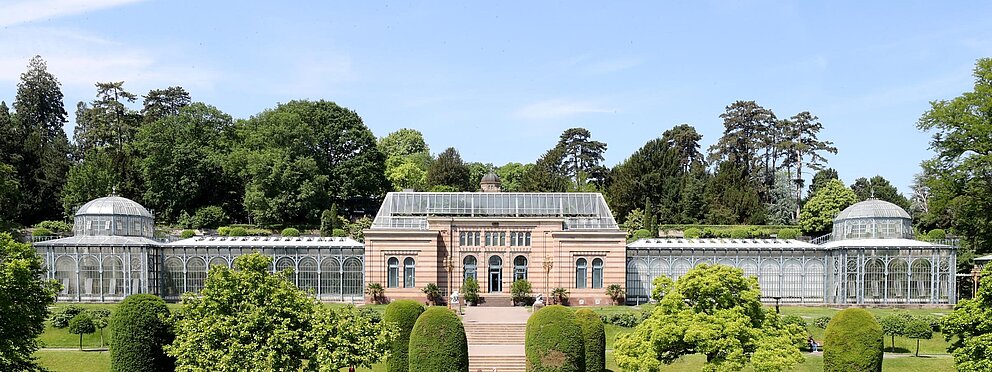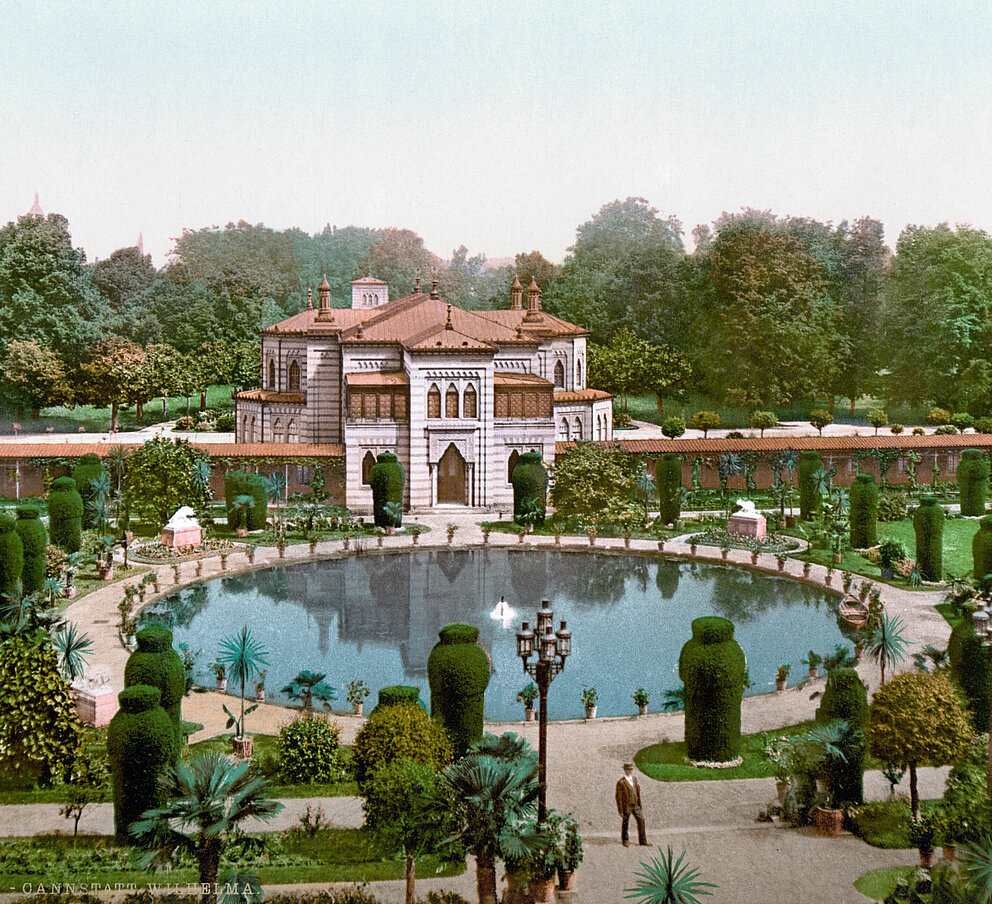
Wilhelma history
It all started with a grand park: In the 1820s, the royal household acquired the area below the Neckar slope, where the Rosensteinpark was created to designs by J. W. Bosch. After its completion in 1829, mineral springs were discovered there, whereupon the ruling King Wilhelm I of Württemberg (1781-1864) wanted to turn the park into a wellness complex with a "bathhouse".
This is how the historical part of today's Wilhelma gradually developed. The bathhouse later became a residence; a theater for royal pleasure was built, pillared walkways and greenhouses were constructed; and the gardens were steadily expanded. Above all, architect Karl Ludwig von Zanth (1796-1857) provided most of the architectural designs that were realized. At the request of the king, the so-called Moorish style was used.
19th century
1837
Architect Karl Ludwig von Zanth is commissioned with the planning. Since the king hesitated to pay the high costs for the ambitious project, it took years until the first building of Wilhelma was completed. The project was close to being cancelled on several occasions.
around 1842
Construction begins on the first building, which is given the name "Wilhelma" on the king's order. The architect Zanth knows how to inspire the king with his ideas and they are carried out despite all resistance. Thus, the "bathhouse" becomes a residence with several rooms, including a domed hall and two adjacent greenhouses, each with a corner pavilion.
September 30, 1846 - Inauguration of Wilhelma
The official inauguration of Wilhelma takes place on the occasion of the wedding of Crown Prince Karl to the Tsar's daughter Olga Nikolaevna. At that time, the extension buildings are far from complete.


1851
The Moorish Banqueting Hall is completed. The two main buildings are connected by an oval covered walkway, encompassing the Moorish Garden with its famed magnolia grove.
1853
With the Gallery Building and the Conservatory called “Winter Garden”, the core area of Wilhelma is completed according to Zanth's plans. This year is referred to for anniversary celebrations.
1856
With the completion of the Damascene Hall based on the plans of architect Wilhelm Bäumer, the expansion of the historical Wilhelma is completed. King Wilhelm I does not live to see it. He dies in the same year as the planting of the redwood trees, today known as the Wilhelma Seed.
from 1880 - first opening to visitors
After the death of Wilhelm I, it took another 16 years before the park became accessible to a wider circle of visitors and was no longer reserved for the royal family. From 1880 onwards, anyone could enter Wilhelma on presentation of an authorization card, which, however, was not easy to obtain.
20th century
1919
Wilhelma becomes state property and is turned into a botanical garden. With the end of the monarchy in Germany, the park is finally opened to the people of Stuttgart.
1944
Large parts of Wilhelma are destroyed or severely damaged by bombing. The Moorish Country House, the former refuge of the king, is restored over the years and converted into a tropical hall with a glass roof and greenhouses. The largely destroyed Moorish Banqueting Hall is demolished except its portal. This piece of the original facade is integrated into the replacement building with aquarium, terrarium and crocodile hall.
1949
After a few years of growing vegetables for Stuttgart hospitals in the post-war period, Wilhelma reopens to guests on March 19, 1949, with a number of exhibitions of azalea, aquariums and on the evolution of plants.
1952 - The first zoological-botanical garden
With the show of "Animals from the African Steppe" in 1951, the first large animals arrive at Wilhelma. Giraffes, zebras and antelopes make the start, followed by penguins. In 1952 the exhibition of "Animals from the Indian Jungle" with elephants and tigers is stage. The animals remain on site after the shows. However, what bodes very well with the guests is not desired by the Ministry of Finance, which decrees: The wild animals have to be removed.
To prevent this, the director Albert Schöchle, who has been in office since 1933, stages the christening of a lion cub with Finance Minister Frank as its godfather. The minister agrees to this deal and thus puts his foot down, so that the animals may stay. From 1952, Wilhelma is officially a zoological-botanical garden.
One of the first residents was elephant Vilja - she moved into the enclosure when she was about three years old and lived here until 2010, before she died at the age of over 60 as the oldest Asian elephant in Europe at that time.


1967
The Aquarium-Terrarium with the crocodile hall is opened on the site of the destroyed Moorish Banqueting Hall. An orangutan is the first ape born at Wilhelma.
1970
Wilbert Neugebauer, who has worked at Wilhelma since 1955, becomes director of the zoological-botanical garden. The annual number of visitors increases from about 1.03 million in 1960 to more than 1.61 million
1975
The rock landscape for African monkeys and climbing animals is completed. The educational programs of the Wilhelmaschule start.
1982
The first residents can move into the new rearing house for offspring.
1989
The curator for the aquarium, Dieter Jauch, becomes director of Wilhelma.
1993
The large bird aviary between the main entrance and the restaurant, as well as the farm, are opened as part of the International Horticultural Show 1993.
21st century
2000
The Albert Schöchle Amazon House is completed – with the financial aid of the Wilhelma Supporters Association. Wilhelma achieves a record number of more than two million visitors for the first time – extrapolated as common at that time.
2007
The building design for the new enclosure for African apes is commissioned. In December, Wilbär is born, Stuttgart's first polar bear offspring ever. He remains the only cub born in Wilhelma.
2013
The new home for great apes – many times larger than its predecessor – is ceremoniously inaugurated and opens in May.
2014
After more than 24 years as Wilhelma director, Prof. Dieter Jauch retires. Dr. Thomas Kölpin succeeds him.


2018
The new mountain landscape for the snow leopards, four times the size of the previous facility, opens at Easter. In July, polar bear Corinna dies at the old age of 28. With her, the husbandry of polar bears at Wilhelma comes to an end.
2020
The new enclosure for Asian ungulates is opened, where Bactrian camels and yaks live together. The latter can be seen at Wilhelma for the first time. The Mesopotamian fallow deer move into their own enclosure next to it.
2021
The former polar bear enclosure with large pools is converted into a landscape enclosure for a female cheetah to promote successful breeding. The males remain in their usual location near Belvedere pavilion except for mating.
2022
The new building for small mammals, birds and insectivores opens at Easter. The building behind the historical conservatory contains 15 enclosures, aviaries and plant beds. This display accommodates the carnivorous plants in the visitor area all year long. For the first time in Wilhelma history, there are offspring among the cheetahs.
